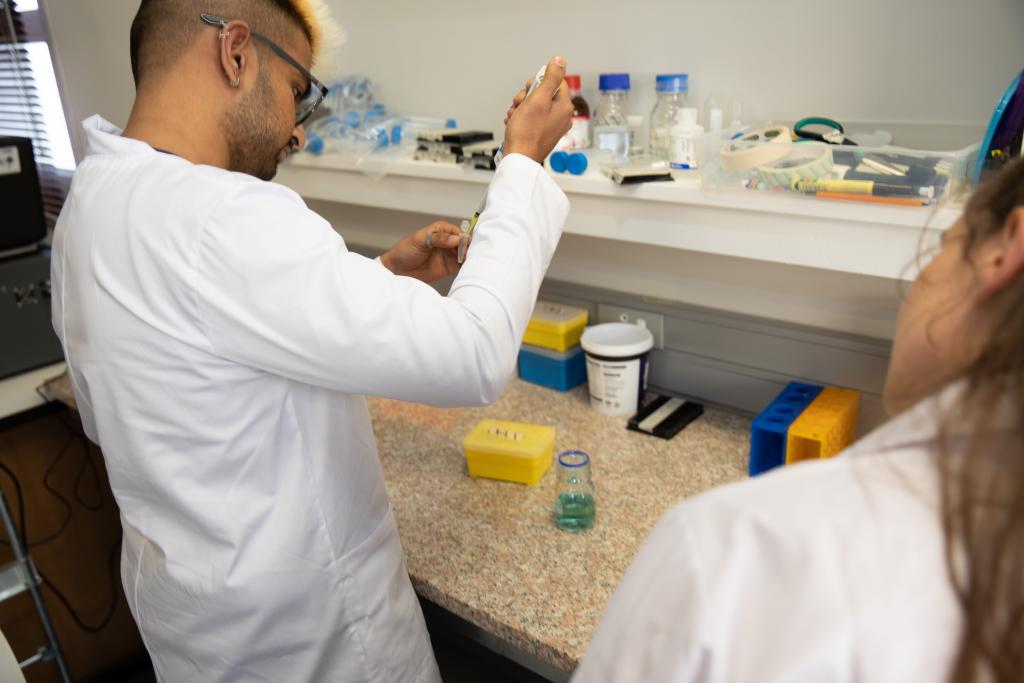
Using the UCT Scientific Computing Research Unit’s uniquely designed software designed and developed by the Life Science HPC Group the Computational GlycoEnzymology Group simulates and models enzymatic reactions. This leads to a detailed mapping of the electronic and geometric profile of the Transition State (TS). Following this, we undertake an informatics-based approach to rationally design Transition State Analogues (TSAs) using tools such as BRIDGE built on the Galaxy platform in the Visualisation Studio. We measure the theoretical stability and ADMET properties and the designed GlycoEnzyme TSA Inhibitor design is then passed to the Organic Synthesis Group where we select TSAs that are chemically stable and can lead to enzyme inhibition for development. These TSA inhibitors are tested on glycoenzymes that are expressed and screened using in-house assays by the Glycoenzyme HTS and Assay Group.
Organic Synthesis Group

Advances in the functional understanding of carbohydrate-protein interactions have enabled the development of a new class of small-molecule drugs, known as glycomimetics. These compounds mimic the bioactive function of carbohydrates and address the drawbacks of carbohydrate leads; namely their low activity and insufficient drug-like properties. Here, we examine approved carbohydrate-derived drugs with a focus on carbohydrate-binding proteins as drug targets for Cancer and Respiratory diseases. The objectives are to develop ways to overcome the synthetic challenges of this unique class of novel therapeutics. This group innovates not only around transition state mimics but employs a repurposed drug strategy as well. Our refined molecular products are passed to the Glycoenzyme HTS Group testing. The instant feedback from this in-house testing facility improves the response time to develop new synthetic routes and leads.
Glycoenzyme HTS and Assay Group
The objectives of this group and associated laboratories are to:
- Express constructs for the production of human glycosylation enzymes (glycoenzymes)
- Develop Assays for glycoenzymes for the purposes of HTS of inhibitors
- Produce data and investigate mechanisms of glycoenzyme cellular action in Cancer and Respiratory diseases for Systems Biology analysis.
The group is active in creating reagents and protocols to produce recombinant human glycosylation enzymes.

Laboratory Infrastructure and Resources

Overall the laboratory produces kinetics and inhibition data for systems biology studies of the role of glycoenzymes in Cancer and Respiratory diseases; in addition to this it serves as an in-house testing facility. The design layout of four physically independent divisions in the Glycobiomedical laboratory has made it a resilient workspace that allowed for multiple researchers to conduct experiments.
1. Bacterial Expression and Assay Lab

This laboratory has several options for incubation: A refrigerated and non-refrigerated Lasec shaking incubators are used for growing small and large bacterial cultures, a Scientific™ incubator for incubation of Petri dishes and other non-shaking incubations and a GFM ThermoLab water bath for pre-heating media. The refrigeration facilities include a Fryka -80 °C freezer for storage of bacterial stocks, enzymes and other temperature sensitive items. The expression is supported by basic equipment such as visible spectrophotometer cuvette readers for bacterial culture OD600 readings; EnsSci E-C15-12.2 benchtop centrifuge with capacity for 12 x 1.5- and 2-mL tubes is used for various purposes including for centrifugal filtering during miniprep and midiprep plasmid extraction, cell pelleting etc; for lysis of protein expression cultures. The necessary analytical balances for measuring smaller samples and weighing out larger materials. A Crison JLP-21 pH meter is available for preparing buffers. Two E. coli strains are available; BL21 DE3 and DH5α which are used for expression and storage respectively, after transformation with the desired plasmid.
2. Human Glycoenzyme Expression and Cell Culture Lab

This BSL-2 lab is equipped with night time auto UV units for pathogen decontamination. It houses a NuAir NU-543 4OOS Biosafety Cabinet for sterile handling of human cell cultures. A ThermoScientific HERAcell 150i CO2incubator with a shaker is in use for incubation of human cell cultures. A CETI Fluorescence Microscope for visualising fluorescently stained cell components is used on cancer cell lines that are analysed for the mechanistic and functional roles of GlycoEnzyme in tumourigenesis. The laboratory relies on the Rotanta 460 R Hettich Centrifuge with a cooling system available for temperature sensitive samples to be spun down. All media, equipment, plasmids and cell lines (HEK and CHO) are available for human glycoenzyme expression.
3. Glycoenzyme Analysis and Purification Lab

This laboratory is equipped with all necessary electrophoresis equipment for DNA gels and SDS-PAGE gels. For SDS-PAGE this includes the Invitrogen Minigel Tank with a PowerEase® power pack, Invitrogen gel stacking equipment, FMH heatblock for denaturing samples, a VWR Rocking Platform and a microwave for staining/destaining gels and all reagents for preparing gels and samples as well as running gels and staining/destaining. For the DNA gels there is Biorad equipment for running and preparing the gels with all necessary reagents for this purpose. A Cytiva GE Healthcare Life Sciences AKTA Start FPLC with fraction collector and Unicorn Software is available for protein purification – this includes all columns (HiPrep Sephacryl size exclusion column and HiTrap IMAC and desalting columns), materials and reagents. A Boston Microscopes Alpha Innotech FluorChem® HD2 gel visualiser is used for visualising gels.
4. High throughput Screening Lab

The High throughput Screening (HTS) and Assay Lab is fully equipped with all instrumentation required to set up and take readings for high-throughput screening assays. This includes two robotic liquid handling systems - Opentron 1.0 and Opentron 2.0 for plating out assays faster and more accurately. The EnVision® Multilabel Plate Reader Model 2104-0020 is capable of reading absorbance, fluorescence (from top and bottom readings) and luminescence allowing for a wide range of assays to be performed. We have clear and black 96-well and 384-well plates available for assays and all reagents necessary for the current assays being run in our laboratory.
